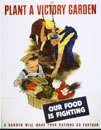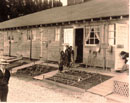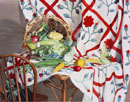Highlights of the Exhibition
The following are some highlights of the exhibition. Members of the media may download high-resolution TIFFs/JPEGs of these photographs by registering here.
 ENLARGE + Credit: Jennifer Radford, photographer. Smithsonian Institution Horticulture, Archives of American Gardens, Garden Club of America Collection. |
Community Garden at Edgerton Park, New Haven, Connecticut, 2000. |
 ENLARGE + Credit: Edward Van Altena, photographer. Smithsonian Institution Horticulture, Archives of American Gardens, Garden Club of America Collection. |
Chinampas at Xochimilco, Mexico, 1920s-1930s. Hand-colored glass lantern slide. Most of the Aztec chinampas have long since fallen into disuse, buried by the urban sprawl of Mexico City. However, the town of Xochimilco ("where the flowers grow") has preserved its chinampas system. Visitors can still take boat rides along the canals and see the gardens awash in flowers and vegetables. |
 ENLARGE + Credit: Eleanor C. Weller, photographer. Smithsonian Institution Horticulture, Archives of American Gardens, Garden Club of America Collection. |
Monticello?s Vegetable Garden in Charlottesville, Virginia, 1984. Thomas Jefferson grew more than 250 vegetable varieties in his 24-bed, 1,000-foot-long terraced vegetable garden. An early champion of the tomato, he constantly tried new varies of vegetables, keeping detailed notes about planting, sprouting, and harvesting times. |
 ENLARGE + Credit: Smithsonian Institution Horticulture, Archives of American Gardens, Garden Club of America Collection. |
The Chimneys? Vegetable Garden in Manchester-by-the-Sea, Massachusetts, 1942. This image shows the Olmsted Brothers' success in minimizing the vegetable garden's appearance. Trellised arches frame the central walk at either end, pulling the viewer's eye straight past the vegetables. Tall, colorful flowers in the border beds conceal the rows of vegetables. |
 ENLARGE + Credit: National Archives and Records Administration. |
Plant a Victory Garden poster, 1943. An estimated 18 million victory gardens in 1942 and 20 million in 1943 sprang up across the country. Abandoned lots, schoolyards, backyards ? even New York City?s Rockefeller Plaza ? were put into production. |
 ENLARGE + Credit: Dorothea Lange, photographer. National Archives and Records Administration. |
Processing Center in San Bruno, California, 1942. Three months after Japan's attack on Pearl Harbor, President Franklin Roosevelt authorized the forced removal and relocation of more than 113,000 Japanese and Japanese Americans living on the West Coast. Individuals and families were taken to processing centers and then to ten relocation centers around the country. Government plans called for the camps to be as self-sufficient as possible. Hundreds of acres surrounding each camp were set aside for internees to cultivate vegetables and other crops. Many also grew smaller vegetable gardens near their barracks to supplement food supplies. |
 ENLARGE + Credit: Harvest, 1979, by Sondra Freckelton (born 1936). Watercolor and pencil on paper. Smithsonian American Art Museum, Gift of Sara Roby Foundation. |
"When I first started gardening, I grew vegetables simply to have the greens of the onions and the multi-hued outer leaves of the cabbage ? subject matter for my watercolors. Painting Harvest, I was unaware of how much I had learned from the garden, but soon realized that the making of the garden had very much to do with the making of art. The garden taught me the value of 'visual rhyme' ? the relationship of similar shape, form, and color to create directions and rhythms, the importance of scale, proportion, and placement in both endeavors..." |
 ENLARGE + Credit: George M. McAfee, Jr., photographer. Smithsonian Institution Horticulture, Archives of American Gardens. |
Sugar Hill Community Education Garden in Houston, Texas, mid-1990s. The not-for-profit Urban Harvest created this garden to show low-income Houston residents what can be grown on a small piece of land. Rev. Willie Jennings, co-creator of the garden, admires the bounty. |
 ENLARGE + Credit: Sarah Hood Salomon, photographer. Smithsonian Institution Horticulture, Archives of American Gardens, Garden Club of America Collection. |
Mulberry House in Potomac, Maryland, 2001. At the dawn of the 21st century, vegetables rule in American gardens. Naturalistic gardens leave vegetables to their own devices. In this Maryland garden, exotic plants thrive under the good graces of St. Francis of Assisi. |

